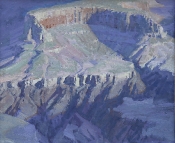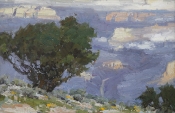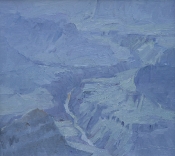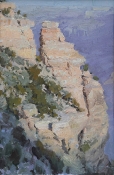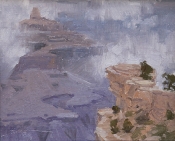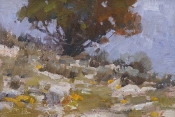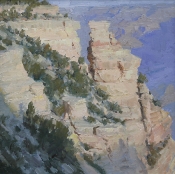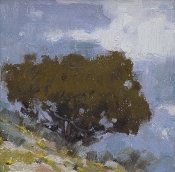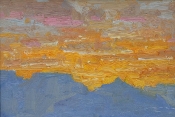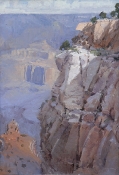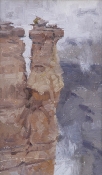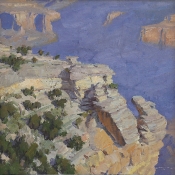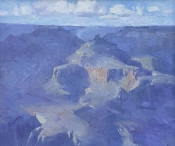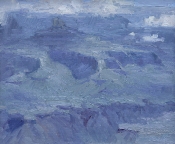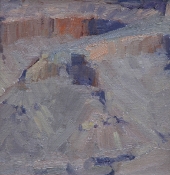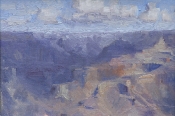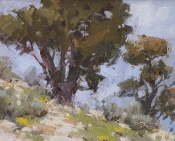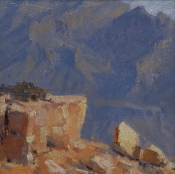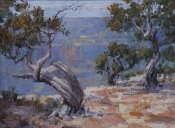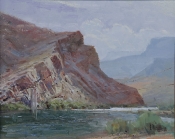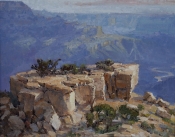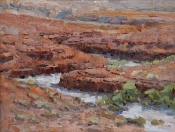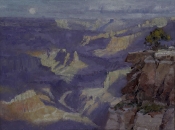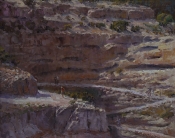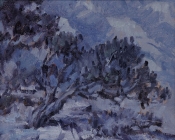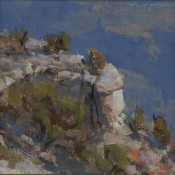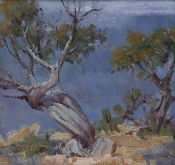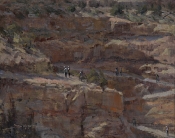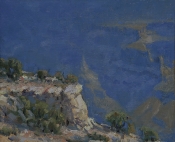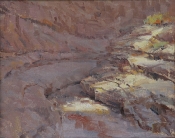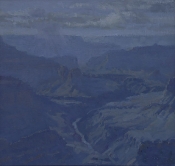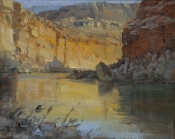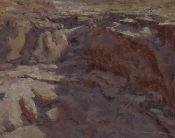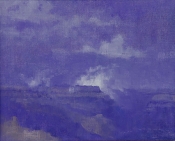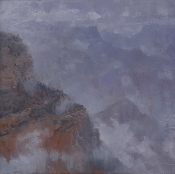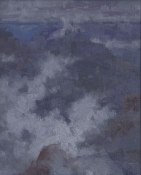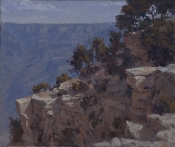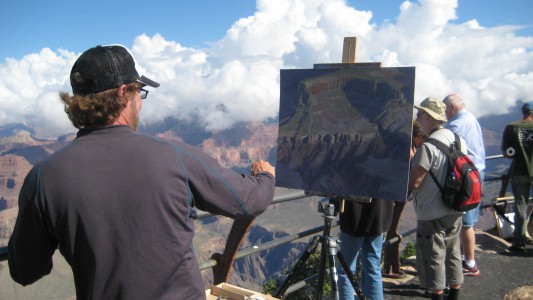 Hands down, this is the most incredible event I do in the year. Every year I come to the south rim, I think there is no way this event will be as good as the year prior, and this year was no exception. This year, and every year since the first year in 2009, they’ve out done themselves!! This year the sales were up by nearly 40% from last year… incredible!! The weather this year was superb with a couple of storms moving through for drama and excitement, but nothing lasting or torrential like last year’s weather. Well it made for an extremely diverse and productive week of work. I spent some more time at one of my old favorites, Yaki point, and a number of days were spent out at Mojave Point on the west rim as well looking into the Abyss. My favorite painting from the week was Temple Shapes done from Hopi Point on the West Rim. Enjoy it Nancy!! A special thanks goes out to all those at Grand Canyon Association for all of their work and to the Grand Canyon enthusiasts that helped make the show an incredible success by purchasing our poetic interpretations of one of the seven wonders of the world. Below is the body of work from this year’s event!!
Hands down, this is the most incredible event I do in the year. Every year I come to the south rim, I think there is no way this event will be as good as the year prior, and this year was no exception. This year, and every year since the first year in 2009, they’ve out done themselves!! This year the sales were up by nearly 40% from last year… incredible!! The weather this year was superb with a couple of storms moving through for drama and excitement, but nothing lasting or torrential like last year’s weather. Well it made for an extremely diverse and productive week of work. I spent some more time at one of my old favorites, Yaki point, and a number of days were spent out at Mojave Point on the west rim as well looking into the Abyss. My favorite painting from the week was Temple Shapes done from Hopi Point on the West Rim. Enjoy it Nancy!! A special thanks goes out to all those at Grand Canyon Association for all of their work and to the Grand Canyon enthusiasts that helped make the show an incredible success by purchasing our poetic interpretations of one of the seven wonders of the world. Below is the body of work from this year’s event!!
- HOME
- EVENTS
- ARTWORK
- TRADE UP
- OIL PAINTINGS
- FUNKBUTTAH
- GEAR 4 PAINTING
- EDUCATIONAL
- THE ARTIST
Tag Archives: Grand Canyon
Grand Canyon Plein Air on the Rim 2012
Grand Canyon Plein Air On The Rim 2011
 This year at the Grand Canyon Celebration of Art, Plein Air on the Rim was one of rain and challenging plein air painting. Ironically, the day we arrived, a wet cold front moved in and stuck to the Canyon like glue until the allotted one week of painting was over, then it moved on. I’ve never seen the Grand Canyon in such beautiful light though. With the rain came fog lifting out of the depth shrouding some features while defining others. All of the sudden the sun would find its way through the clouds and illuminate parts of the canyon with diaphanous rays of light. Then just as you got in to the bulk of the painting, lightning and rain would humble you and chase you back to the vehicle. Somehow or another, I managed to get a huge amount of work done though. I painted 21 paintings, and 20 made the cut and went in to the show for sale. The one that didn’t was a forced cloud painting that I learned from, but wasn’t composed well enough to be part of the body of work, so you’ll never see it!!
This year at the Grand Canyon Celebration of Art, Plein Air on the Rim was one of rain and challenging plein air painting. Ironically, the day we arrived, a wet cold front moved in and stuck to the Canyon like glue until the allotted one week of painting was over, then it moved on. I’ve never seen the Grand Canyon in such beautiful light though. With the rain came fog lifting out of the depth shrouding some features while defining others. All of the sudden the sun would find its way through the clouds and illuminate parts of the canyon with diaphanous rays of light. Then just as you got in to the bulk of the painting, lightning and rain would humble you and chase you back to the vehicle. Somehow or another, I managed to get a huge amount of work done though. I painted 21 paintings, and 20 made the cut and went in to the show for sale. The one that didn’t was a forced cloud painting that I learned from, but wasn’t composed well enough to be part of the body of work, so you’ll never see it!!
My method of staying dry and productive was to start a LOT of paintings one day and come back the next to work on or finish them. The picture you see above was one of the chilly mornings at Moran Point. This is a 20×24 and no small task! The Light would come and go so I had to stick with one or the other, I chose light. When it would come out I would furiously paint everything illuminated and study the color in the shadows, and take some “mental snap shots.” This was the first day of this painting and I was just about to wrap it up for the morning and come back the next day to finish. Marie Charvet was wandering the various points on this day and took this focused shot of me. We were talking about her travels to the United States from France, and she explained how it had been a great trip hence far when her rental car got Struck by Lightning and wouldn’t work any more the night before. She had to sleep inside waiting for the company to bring her another!
For all you plein air painters out there, I highly recommend getting in to this show. It is one of the best ones that I do in the year. The staff at the Grand Canyon Association is second to none and they are soooo organized. Opening night SOLD 15 of those 20 paintings and the quickdraw earlier that day had one of the best auctioneers and was attended by some Heavy Hittin’ Grand Canyon Art Collectors. The painting I did got bid up in a war to a whopping $2000.00. It helped that I got the People’s Choice award for that painting, of course!! The judges of the show picked the painting, Clinging Clouds, below to win the 2nd place overall prize too!! All in all it was the most successful show that I’ve done to date, and I thank everyone at the GCA, the sponsors of the show, the judges, and the Grand Canyon enthusiasts and collectors.
The complete body of work is below. For availability, go to the navigation bar above, roll over paintings, then Landscapes. Thanks for checking out the post!!
Grand Canyon, Moran Point Demonstration
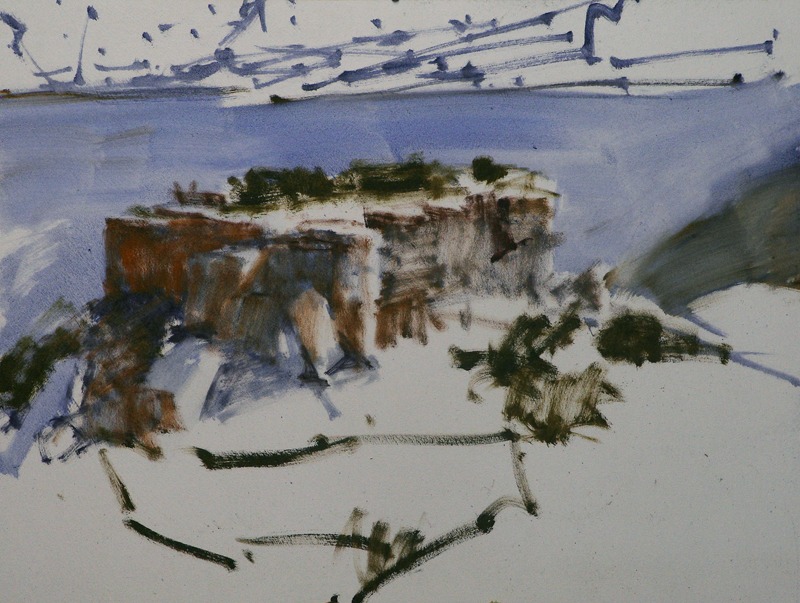 STEP 1. I decided to photograph this demonstration right after I started it, so I lost what I would consider the actual first step. Before this, would be just a quick line drawing like what you see at the bottom of this step. I loosely outline the integral shapes and think about how those shapes interact with each other. Also at this step I think it’s equally important to think about the “unseen” lines that tie parts of the composition together.
STEP 1. I decided to photograph this demonstration right after I started it, so I lost what I would consider the actual first step. Before this, would be just a quick line drawing like what you see at the bottom of this step. I loosely outline the integral shapes and think about how those shapes interact with each other. Also at this step I think it’s equally important to think about the “unseen” lines that tie parts of the composition together.
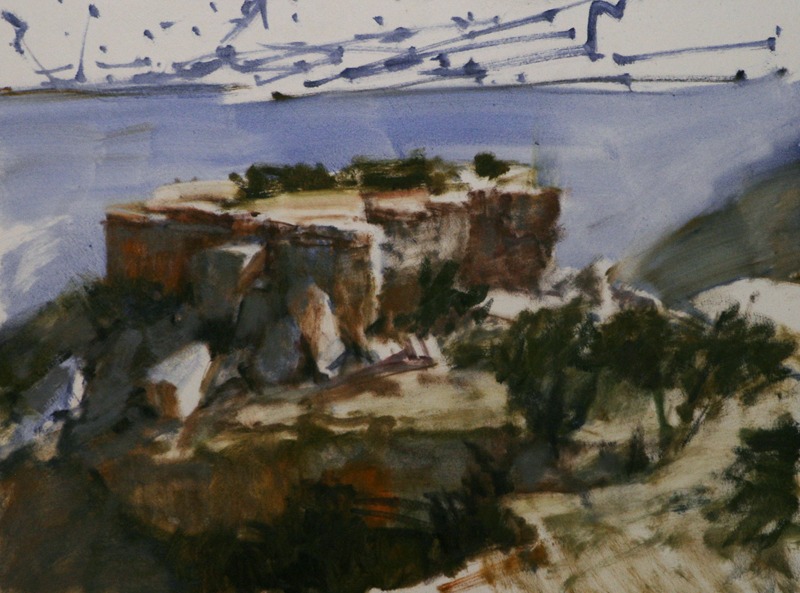 STEP 2. I start filling in the shapes. I first think in terms of 2 values: the light family and the shadow family. When handling dark valued entities like the junipers and pinyons, their light and shadow families are less discernible than the values in the rocks, so I just connect them with the shadow family. Then I work in the middle values like the background that is heavily influenced by the atmospheric perspective.
STEP 2. I start filling in the shapes. I first think in terms of 2 values: the light family and the shadow family. When handling dark valued entities like the junipers and pinyons, their light and shadow families are less discernible than the values in the rocks, so I just connect them with the shadow family. Then I work in the middle values like the background that is heavily influenced by the atmospheric perspective.
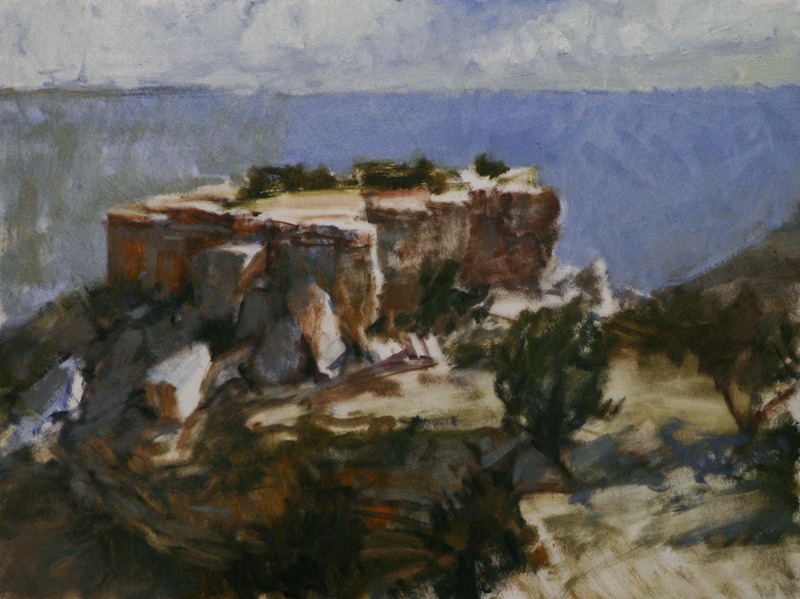 STEP 3. Almost immediately I go in with some notification of temperature relationships within the shapes. Reflected light is responsible for more saturation in the color within the shadows than local color. I have left the light family of the rocks mostly just the white of the canvas for contrast and will keep it that way for a few more steps.
STEP 3. Almost immediately I go in with some notification of temperature relationships within the shapes. Reflected light is responsible for more saturation in the color within the shadows than local color. I have left the light family of the rocks mostly just the white of the canvas for contrast and will keep it that way for a few more steps.
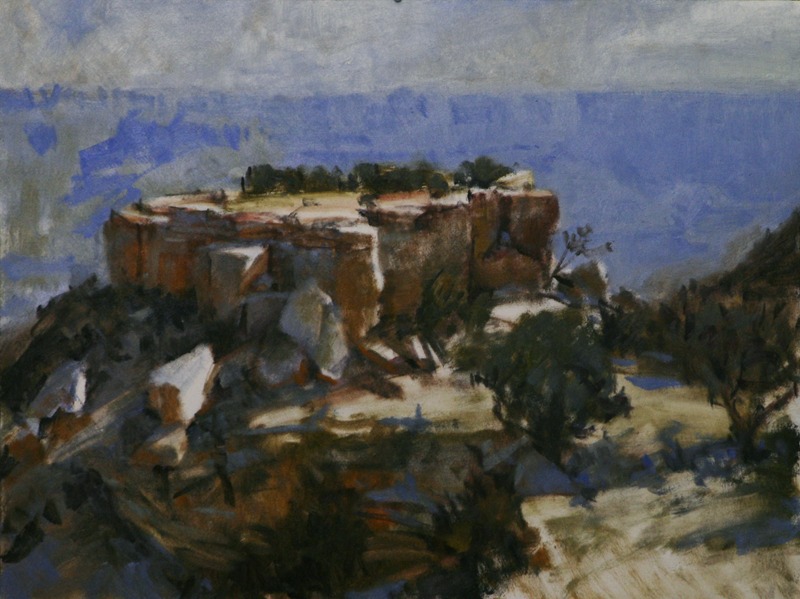 STEP 4. This is where I will place most of the accents. I consider both hi-lights and darkest darks accents, but in this case, I’m talking about the dark accents (the cracks and crevices in the rocks, the trunks of the trees, etc.). This begins to really define the structure of the rocks and whatnot.
STEP 4. This is where I will place most of the accents. I consider both hi-lights and darkest darks accents, but in this case, I’m talking about the dark accents (the cracks and crevices in the rocks, the trunks of the trees, etc.). This begins to really define the structure of the rocks and whatnot.
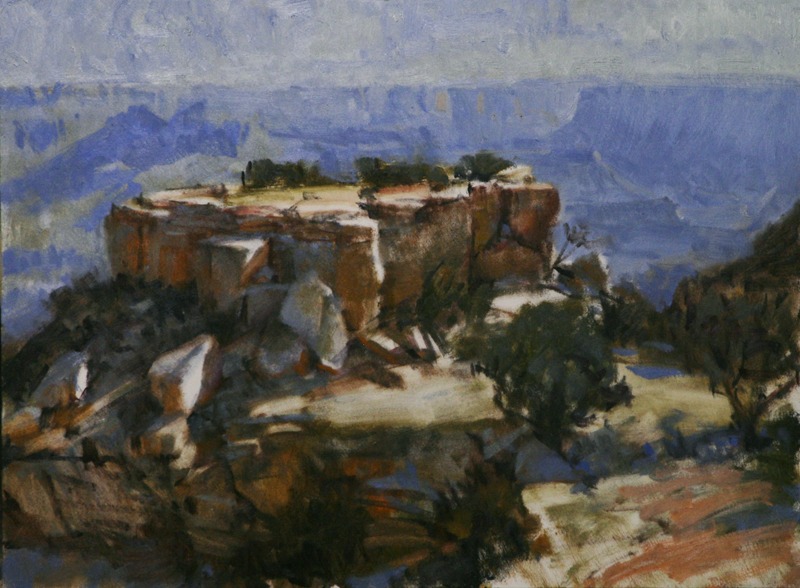 STEP 5. I redrew the bottom left portion of the rocky ledge for accuracy. For this prominent point, I really am after a sort of portrait of this formation. It is Moran Point at the Grand Canyon, a point where Thomas Moran was said to have painted the area in the late 1800s. This ultimately helped name the canyon a national park, thus preserving it for our and future generations. I’ve also started mixing and painting the dirty areas on the rocks surface as seen in the lower right.
STEP 5. I redrew the bottom left portion of the rocky ledge for accuracy. For this prominent point, I really am after a sort of portrait of this formation. It is Moran Point at the Grand Canyon, a point where Thomas Moran was said to have painted the area in the late 1800s. This ultimately helped name the canyon a national park, thus preserving it for our and future generations. I’ve also started mixing and painting the dirty areas on the rocks surface as seen in the lower right.
 STEP 6. I have started painting the lit areas of the rock formation. I am careful here to define the side plane of the rocks as the planes receiving most of the light. By controlling this aspect I can effectively change the time of day to earlier morning, making the sun seem lower in the sky.
STEP 6. I have started painting the lit areas of the rock formation. I am careful here to define the side plane of the rocks as the planes receiving most of the light. By controlling this aspect I can effectively change the time of day to earlier morning, making the sun seem lower in the sky.
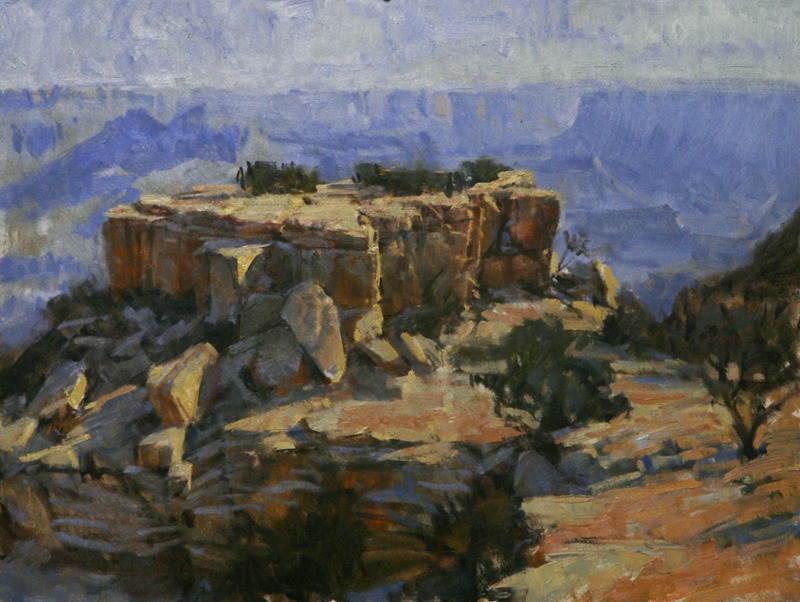 STEP 7. More refinement of planes and their respective reflective light. Some more definitive treatment of the trees.
STEP 7. More refinement of planes and their respective reflective light. Some more definitive treatment of the trees.
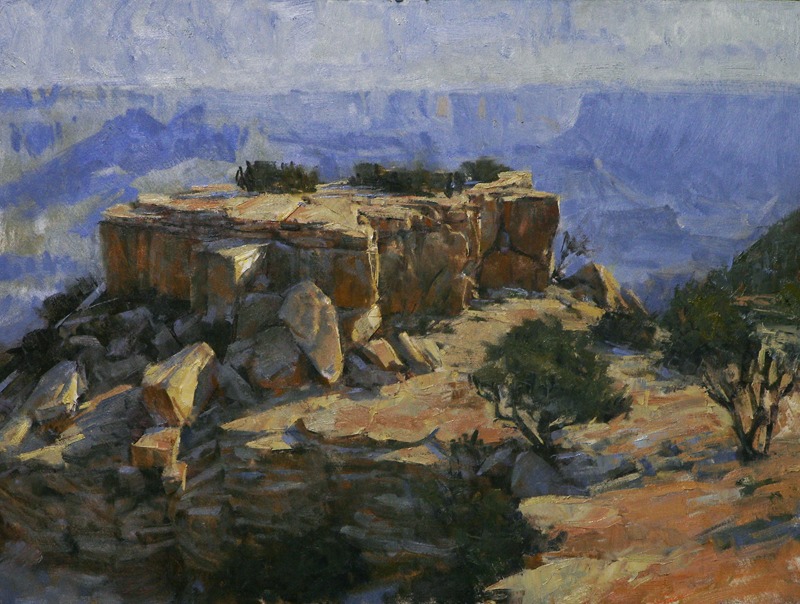 STEP 8. Further refinement of the side plane of the lit rocks. Also refining the background atmosphere. I am trying to define some the distant formations without losing the focus on the foreground. I have also started spending more time on the trees and am defining their plane changes and describing the form of their dark canopies.
STEP 8. Further refinement of the side plane of the lit rocks. Also refining the background atmosphere. I am trying to define some the distant formations without losing the focus on the foreground. I have also started spending more time on the trees and am defining their plane changes and describing the form of their dark canopies.
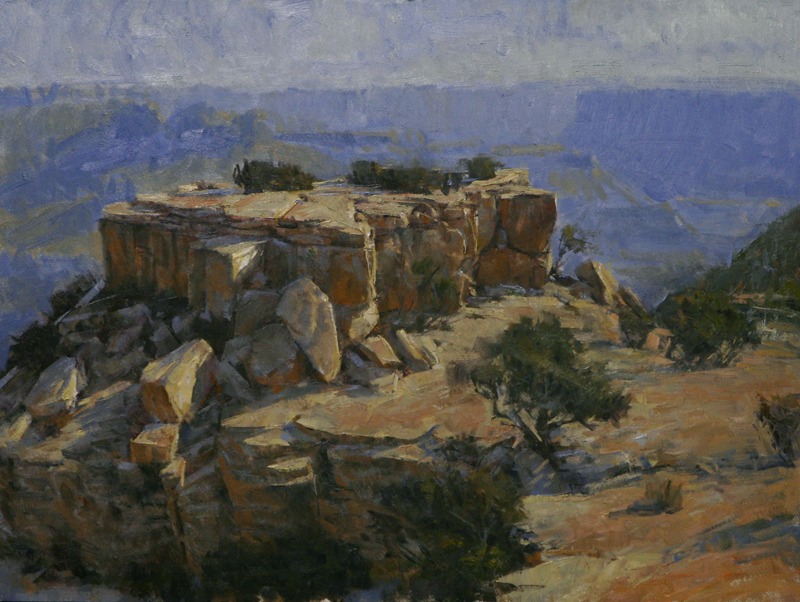 STEP 9. I realized that the trees on the right were clumsy and made entering the painting somewhat cumbersome. The solution for me was to eliminate some of them in order to organize the foreground a bit further. Before finishing, I wanted to describe some more of the distant walls and formations, while again, not taking away from the foreground. I also drug some darker value through the shadowed side planes of the rock to create the effect of desert varnish.
STEP 9. I realized that the trees on the right were clumsy and made entering the painting somewhat cumbersome. The solution for me was to eliminate some of them in order to organize the foreground a bit further. Before finishing, I wanted to describe some more of the distant walls and formations, while again, not taking away from the foreground. I also drug some darker value through the shadowed side planes of the rock to create the effect of desert varnish.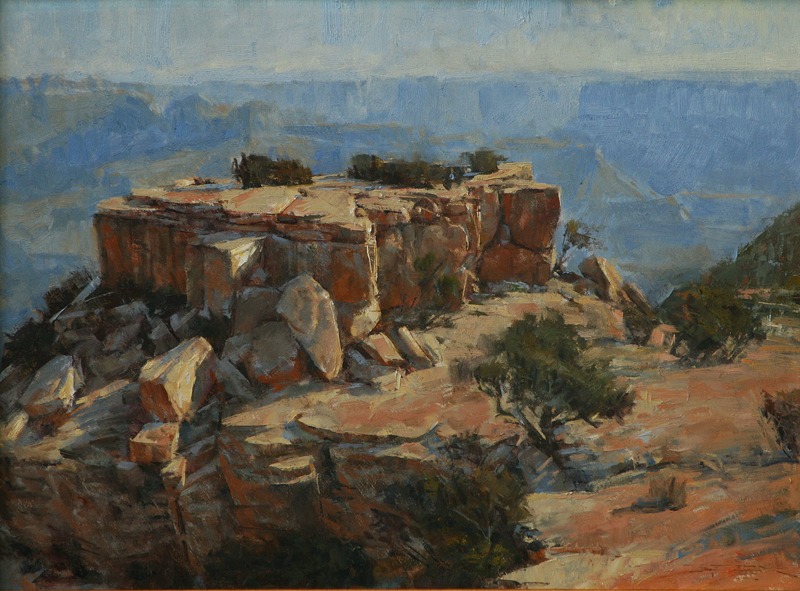
“Historical Inspiration” 18X24 Oil

